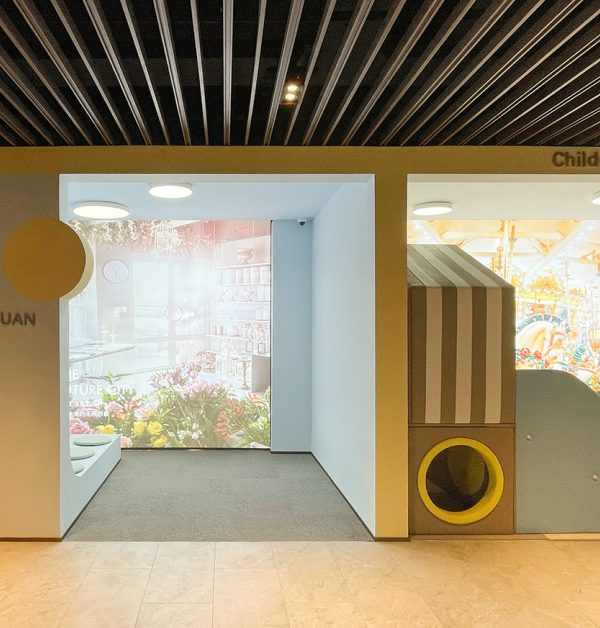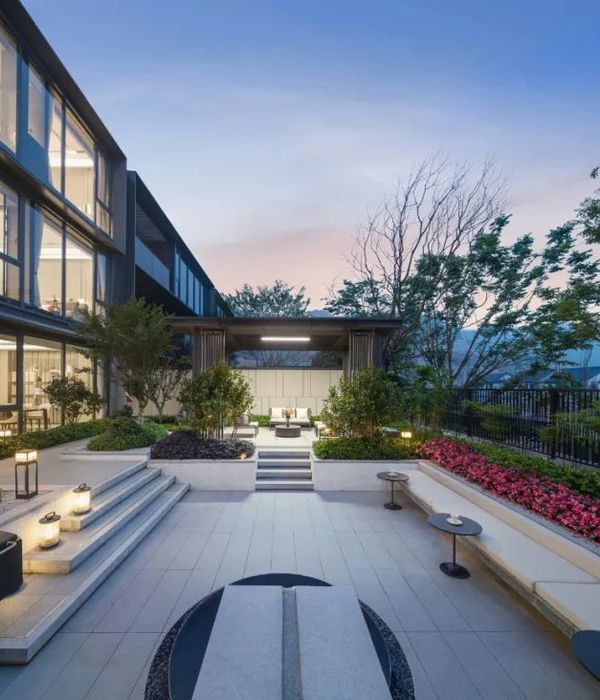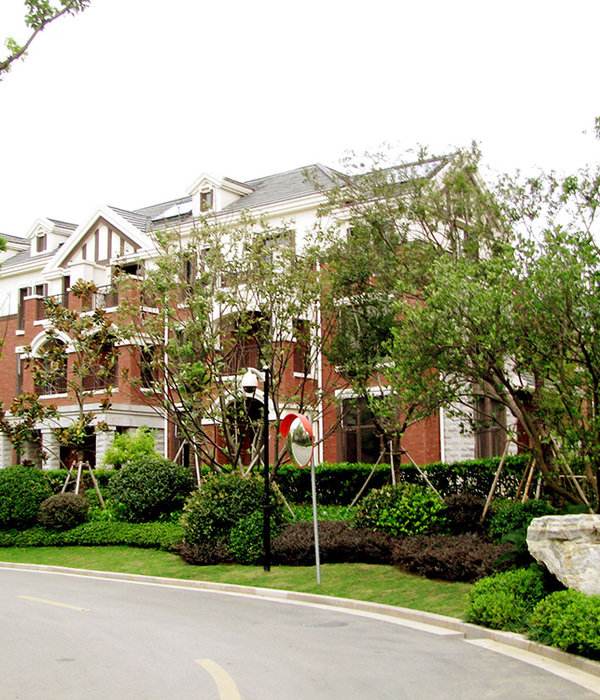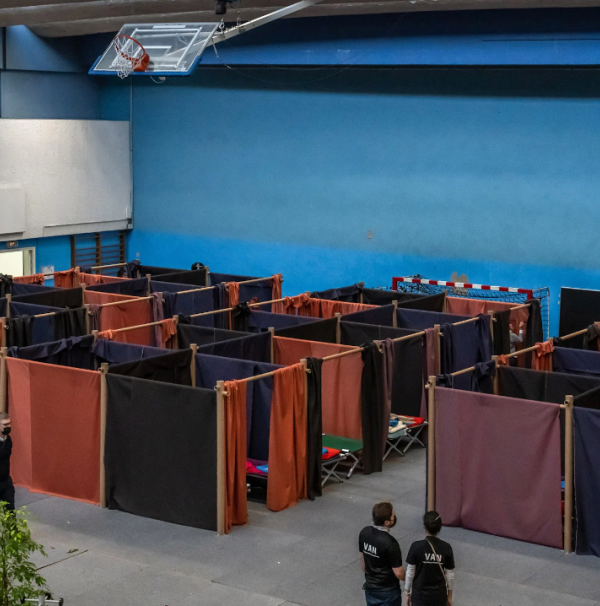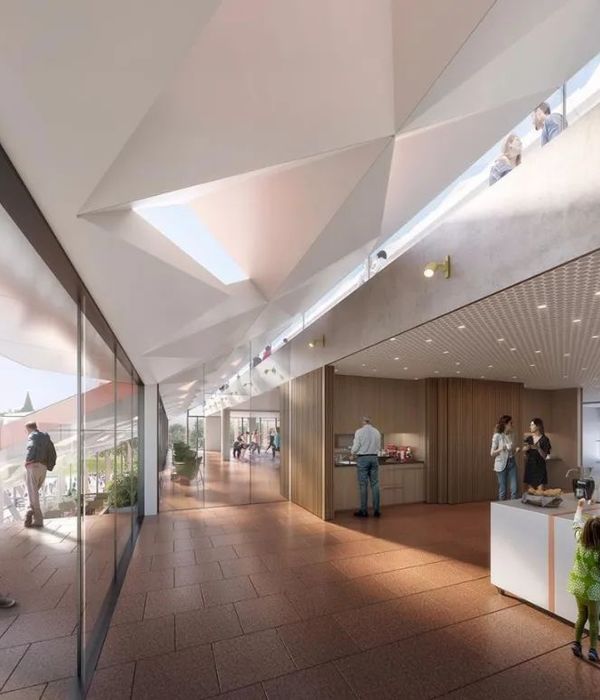国家马车博物馆的新场馆建造主要关注了两个问题: 一方面,作为博物馆,该项目的设计以较高标准来确保收藏品的安全,例如使用保险箱的形式陈列这些独特的历史遗产;另一方面,从城市角度考虑,在政府“贝伦·雷德斯科贝塔(Belém Redescoberta)”的项目框架下,设计团队尝试将新建筑完美整合到这一纪念性城区。基于此,项目同时建造了沿Calçada da Ajuda路的人行天桥,天桥横跨铁路直达附近的港口。该区域北侧沿Rua da Junqueira有一片历史性社区,天桥的出现为该地段增添了许多魅力。
▼博物馆概览,overview ©Ana Paula Carvalho, Arménio Teixeira, FG+SG- Fernando Guerra
A project such as the one for the new installations of the National Carriages Museum raises two main questions. Regarding the museology the project adopts a criteria focused on the definitive preservation idea of the collection, to held safe such a unique heritage, like in a treasure chest; from the urban point of view, finding the accurate spatial disposal committed to its integration in a monumental area of the city, framed by the governmental program “Belém Redescoberta”. In this aspect, one should refer the footbridge, in line with Calçada da Ajuda, crossing the railway and reaching near the harbour. As well as the existing historical neighbourhood along Rua da Junqueira, facing the north side of the plot, and lending a great deal of enchantment to the place.
▼项目鸟瞰,aerial view ©Ana Paula Carvalho, Arménio Teixeira, FG+SG- Fernando Guerra
从项目的最终呈现可以看出,博物馆建筑被设计成双重空间:一个主展览馆搭配机库及一座附楼,通过一系列连续坡道引入室内空间,人行天桥也由此开始。建筑体块结合人行天桥形成的横向关系,构成的柱廊式空间形成进入内部庭院的入口。紧邻重新设计过的Rua do Cais da Alfândega Velha,伫立着现存的古老建筑。我们有理由相信,如今这个受到严格保护且开放日期不定的博物馆,将作为城市新的公共空间,迎来大量游客。
As the project reveals from itself, the construction is proposed in a dual form: a main Exhibition Pavilion with a lifted hangar and an Annexe building, and strategically integrating in its interior, by a succession of ramps, the footbridge start. The volumes disposal, together with the horizontal line drowned by the footbridge, configures a portico that stages an entrance to the interior courtyard. Here we discover the ancient existing buildings, facing now the redesigned Rua do Cais da Alfândega Velha. From this point we can imagine what can be the city flows crossing the museum, inside and outside, what will become the new museum as a public place – strictly protected and unpredictably open.
▼设计草图,design sketch ©Bak Gordon Arquitectos
▼建筑模型,项目由两个主要空间体块构成。Model, the construction is proposed in a dual form ©Bak Gordon Arquitectos
博物馆和旧城区之间形成了新的庭院,庭院路面铺设了随意排布的黑色花岗岩石材。这样的设计,与城市复杂而精细的建筑尺度形成对比,使游客在行进过程中获得丰富的尺度感及空间体验。建筑下发出柔和的光线,使建筑看上去好似漂浮着的发光屋顶。笼罩在这样的光线中,即使在夜晚,庭院里也能自由的通行。
▼新老建筑间形成庭院,new courtyard extend between the museum and the historical city ©Ana Paula Carvalho, Arménio Teixeira, FG+SG- Fernando Guerra
▼庭院地面铺设黑色花岗岩石材, courtyard freely disposed in a unique surface of black granite stone pavement ©Ana Paula Carvalho, Arménio Teixeira, FG+SG- Fernando Guerra
The new courtyard between the museum and the historical city extends itself underneath the two volumes, freely disposed in a unique surface of black granite stone pavement. On the other hand, this contrasts with the small intricate scale of the upper city level, creating a profusion of accessibilities with diversified scales and crossing experiences. Here we can walk freely even at night, in the comfort of the light emanated bellow the buildings, like a suspended illuminated roof.
▼建筑下的柔和灯光,the comfort of the light emanated bellow the buildings ©Ana Paula Carvalho, Arménio Teixeira, FG+SG- Fernando Guerra
建筑高出地面的一层,设立于15根直径1.8米的混凝土柱上。轻量墙体构成的白色六面体空间,能够很好的应对钢结构的移动及膨胀。白色六面体上精巧的开窗,展现出内在钢结构支架的形状。
博物馆一楼的入口被安置于一个透明的玻璃空间内,增强了外部公共空间的视野。入口空间与混凝土建造的不透明私人及工作区域形成对比。通过狭窄的开窗可以看见这些区域内的活动。玻璃建造的自助餐厅位于建筑西侧,该空间再次完全向庭院开放。
The Exhibition Pavilion develops one level above the ground and rests on fourteen Ø1.8m concrete pillars. A white parallelepiped with weightless walls, capable of absorbing the movements and dilatations of the steel super structure. Small and insightful openings where subtracted to the white abstract volume, revealing the shape of the steel trusses.
On the ground floor, the museum entrance is located on a glass volume, transparent, enhancing the sights of the exterior public place, and contrasting with the opaque concrete volume where we find the museum private areas and the workshops, from which activity can be observed through the narrowed openings. On the west side of this volume, again a entirely glazed cafeteria opens up towards the gardens.
▼展览区,建筑架于混凝土柱上。Exhibition pavilion rests on concrete pillars. ©Ana Paula Carvalho, Arménio Teixeira, FG+SG- Fernando Guerra
▼展览区建筑外墙细节,facade detail ©Ana Paula Carvalho, Arménio Teixeira, FG+SG- Fernando Guerra
▼展览区细部,detail of exhibition pavilion ©Ana Paula Carvalho, Arménio Teixeira, FG+SG- Fernando Guerra
除了必要的防火通道,该建筑的所有垂直入口都必须通过电梯进入。博物馆主入口由两个一层高的大型电梯连接,每个电梯每次可以乘载75名游客。随着楼层向上,机库的特征慢慢显现。机库由大型抛光混凝土板建造,长长的白色墙体和金属网格支撑起屋顶,内部所有设施排列的井然有序,并加以色彩区分。博物管的参观之旅还将因高处的廊架而与众不同,在桥上,游客可以看到陈列的展品并进入室外游廊,城市景观将在眼前呈现。
主机库尺度为125x17m,被设计为画廊,其内的中心区域布置有出入口,临时展厅和日常工作室。平台式的升降机保证了博物馆展品能够安全的运送至一楼的储藏间。二楼空间不属于游览路线,包含教育服务区,两个放置了大量技术设备的庭院和通往副楼的连廊。
▼展览区的白色的墙体及金属支撑的网格式屋顶,white walls and the steel grid of the suspended ceiling ©Ana Paula Carvalho, Arménio Teixeira, FG+SG- Fernando Guerra
▼空间高处的廊架将带来非凡的游览体验, visit tour is marked by the upper bridges ©Ana Paula Carvalho, Arménio Teixeira, FG+SG- Fernando Guerra
We choose, besides the necessary fire escapes, that all vertical access should be ensured by lifts. The museum main entrance is achieved by a single story journey on two generous lifts, capable of transporting each one 75 people at a time. As we reach the upper floor, two main hangars are characterized by the continuous polished concrete slab, long white walls and the steel grid of the suspended ceiling, inside which, all infrastructures are kept organized and colour identified. The visit tour is also marked by the upper bridges from where we can see the collection from above and access the exterior veranda and discover again the cityscapes.
The main hangars hold the gallery, each with 125x17m, are intercalated with a central space where we find the access points, temporary exhibitions room, and a daily workshop where a platform lift assures the carriages transportation to the storage on the ground floor level. The second floor integrates (besides the visitor’s circuit) the educational service, two outdoor patios where much of the technical equipment is located, and a single connection to the Annex building.
▼廊架下的展览空间,exhibition space under the bridge ©Ana Paula Carvalho, Arménio Teixeira, FG+SG- Fernando Guerra
附楼设置于Rua da Junqueira与Praça Afonso de Albuquerque的交叉路口,是由混凝土骨架及两层玻璃墙构成的空间,其内包含餐厅及行政区域。附楼下方的礼堂也是混凝土建筑,屋顶上有一片水池。在开敞的混凝土结构内,顺着公共及私人通道设有若干小体量空间,通道上方加盖有钢结构天窗。尽管这两座建筑有不同建造过程及配置(钢及混凝土;一个是完全不透明的空间,另一个则是完全开敞),但仍有一些结构策略上的相似之处,例如混凝土底板及吊顶。
The Annexe building is located in the cross between Rua da Junqueira/Praça Afonso de Albuquerque. It is an empty concrete skeleton suspending two glazed volumes: the restaurant and the administration one. Underneath, the auditorium volume also in concrete has a lake on its roof. Inside the empty concrete structure, several volumes are disposed corresponding to accesses (both public and private) sheltered by a central steel structure skylight. Although both buildings have their own constructive processes and configuration (steel and concrete, a pure opaque volume and an empty one), some constructive solutions are similar: the concrete floors and the suspended ceilings for instance.
▼附楼,annexe building ©Ana Paula Carvalho, Arménio Teixeira, FG+SG- Fernando Guerra
▼附楼吊顶,ceiling of annexe building ©Ana Paula Carvalho, Arménio Teixeira, FG+SG- Fernando Guerra
礼堂没有按照规则式建造,相比于正式的房间,更像是一个有盖的看台。马车可以经由两个金属门进入室内,并穿过“舞台”区域。 在舞台上方,宽敞的游廊横跨轨道。我们可以从这里步行至Rua da Junqueira,或上到人行天桥的一半位置。两架天桥连接了二楼的餐厅及行政区域。站在室外的天窗下,可以欣赏到水面上反射的热烈阳光,并看到城市的景象。餐厅及行政区域的东西两侧都装有巨大的玻璃幕墙。餐厅是一个开敞空间。行政区域内设置有博物馆导演及策展人办公室,一个图书馆及一架横架于两座建筑之间的白色廊桥,廊桥从中央安保处通往展览区域。
▼阳光自天窗投下,反射到水面上。Sunlight falls from the skylight and reflects on the water. ©Ana Paula Carvalho, Arménio Teixeira, FG+SG- Fernando Guerra
The auditorium was imagined informal, like a covered grandstand in contrast with a more standard room. Two industrial gates allow a carriage to cross the entire interior through the “stage” area. On its upper level, a generous veranda swings over the trams passing by. From this point we can reach Rua da Junqueira or pick the footbridge half way. Two bridges connect the restaurant and the administration on the second level. Underneath the skylight but yet in the outside space, we can enjoy the dramatic sunlight reflecting on the lake and watch the city passing down bellow. Both restaurant and administration volumes have glazed walls towards east and west. The restaurant is an open space. The administration volume allocates the director and curators offices, a library and the connection to the Exhibition Pavilion through the security central station – a blind white bridge volume, standing between the two buildings.
▼礼堂内部,inner space of auditorium ©Ana Paula Carvalho, Arménio Teixeira, FG+SG- Fernando Guerra
▼舞台区域,”stage”area ©Ana Paula Carvalho, Arménio Teixeira, FG+SG- Fernando Guerra
人行天桥起始于副楼下方,分隔了公共及私人区域。天桥架于铁路上方7.5米,一端是一段35米长的缓坡,穿过展览馆的西侧,另一端于河岸边向下。
As for the footbridge, the dichotomy between public and private remains, starting itself as mentioned underneath the Annex building, in a succession of three 35m ramps, crossing all the west side of the Exhibition Pavilion, 7.5m above the railway and getting down near the river side.
▼夜晚的博物馆,museum at night ©Ana Paula Carvalho, Arménio Teixeira, FG+SG- Fernando Guerra
▼建筑规划范围,project location ©Bak Gordon Arquitectos
▼建筑平面,plans ©Bak Gordon Arquitectos
▼建筑各方向剖面,sections ©Bak Gordon Arquitectos
Authorship. Paulo Mendes da Rocha, MMBB, Bak Gordon Arquitectos, Afaconsult Architecture. Paulo Mendes da Rocha, Fernando de Mello Franco, Marta Moreira, Milton Braga, Ricardo Bak Gordon Architecture Coordination. Nuno Tavares da Costa Collaboration. Edison Hiroyama, Giovanni Meirelles, José Paulo Gouvêa, Luís Pedro Pinto, Pedro Serrazina, Marina Sabino, Nuno Velhinho, Rui Cancela, Sónia Silva, Vera Higino, Walter Perdigão Engineering. Afaconsult Engineering Coordination. Rui Furtado, Armando Vale Consultants. Rui Furtado, Armando Vale, Filipe Arteiro, Miguel Pereira (Foundation and Structure), Marta Peleteiro, Paulo Silva (Hydraulics and Gas), Luís Oliveira (Electrics, Telecommunications and Security), Bruno Henriques, Luísa Vale, Marco de Carvalho (Mechanics), Isabel Sarmento (Energy Certification), dBLab – Alexandre Correia Lopes, Rui Ribeiro, Rodrigo Tomaz (Acoustics), Proap (Landscape Architecture), Nuno Sampaio Arquitectos (Exhibition Project), António Queirós Design (Graphic Design) Site location. Belém, Lisboa Client. Frente Tejo / Portuguese Estate Contractor. Mota-Engil / Martifer / FDO Areas. 16170m2 construction area Date. Works completion in 2015 Cost. 32.000.000€ Photographs. Ana Paula Carvalho, Arménio Teixeira, FG+SG- Fernando Guerra
{{item.text_origin}}

